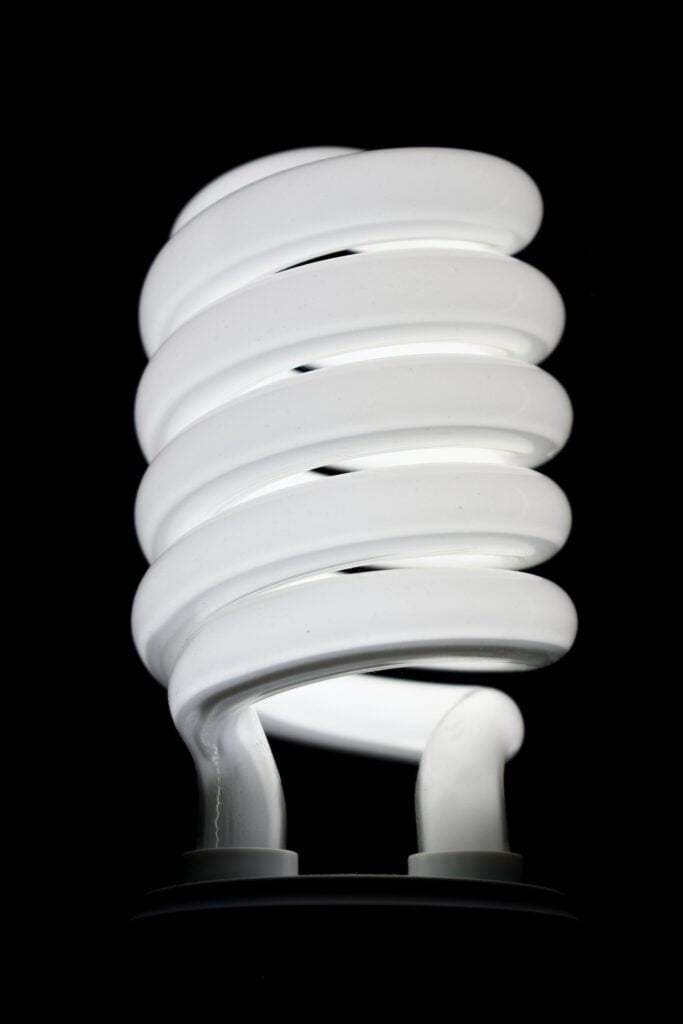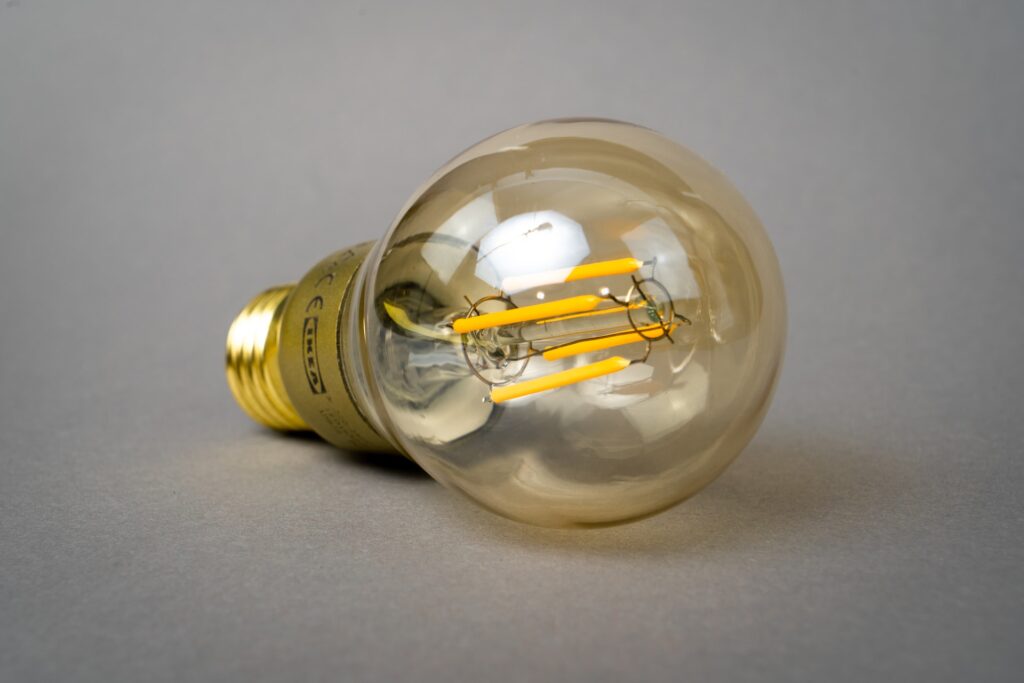By Tony Gilbert
Lighting is one of the most inexpensive and cost-effective ways people can increase their energy efficiency. Changing lighting in the home does not have to cost thousands of dollars, and it can significantly increase the comfort level of each room. By considering energy-efficient lighting options, people could reduce energy consumption without compromising on the lighting they need for cooking, cleaning, hobbies, or leisure activities. With this information, you will know the most common lighting options on the market and how to make the right choice for each room, whether you own your home or are looking for eco-friendly rental improvements.
Types of Energy-Efficient Light Bulbs
There are many types of light bulbs available for purchase. The most energy-efficient options include compact fluorescent and light-emitting diode. Understanding the differences between these two types helps people make the most effective choice.

Compact Fluorescent (CFL)
Compact fluorescent bulbs were one of the first energy-efficient options on the market. These bulbs follow a different process to produce light than an incandescent bulb. As a result, they use about a quarter of the energy while producing an equivalent amount of light.
Compared to incandescent bulbs, CFL bulbs have a much longer lifespan. Although CFL bulbs are still popular for some applications, they tend to be less valuable than LED bulbs because they are non-dimmable. CFL bulbs also cannot be placed into a recessed lighting fixture, a popular style for many rooms.

Light Emitting Diode (LED)
Light-emitting diode bulbs became popular in the early 2000s for several reasons. These include:
- Longer lifespan, up to 10 to 15 years
- Better energy efficiency even than CFL bulbs
- Options to add different colors
- Smart home connectivity
LED bulbs are now the standard for most lighting applications, although you can find incandescent, halogen, and other options. While LED bulbs originally cost several times the amount of an incandescent bulb, prices have come down significantly in recent years. LED lights are even considered one of the best high-ROI energy-efficient home improvements. Now, you can buy LED bulbs for a similar price to incandescent bulbs.
Choosing Alternatives to Incandescent Bulbs
When you start shopping for energy-efficient lighting options, keep a few things in mind. First, the best way to compare output is in lumens produced, not watts consumed. For example, an LED bulb that uses 13 watts may still produce 800 lumens, comparable to a 60-watt incandescent bulb. Second, many modern light fixtures use integrated LED lighting systems. With these fixtures, the LEDs are integrated into the fixture, so they do not require an additional bulb. This also means that you cannot replace the bulbs in the fixture when they wear out, so you would need to replace them instead.
How to Choose Lighting for the Home
When choosing energy-efficient lighting options for the home, there are several factors to consider. By evaluating each option based on these aspects, you can select the lighting most appropriate.
Brightness
Light bulbs vary in brightness due to several factors, including output and direction. The number of lumens indicates the brightness, with an 800-lumen light bulb being fairly bright for most applications. The direction the light goes can also change the way it feels. Up lights tend to be more indirect, while down lights can draw emphasis. The right one depends on the application.
People may often want to use more than one lighting option to illuminate a room. A combination of ceiling lights, floor lamps, wall sconces, and natural lighting may provide a reasonable illumination level without feeling harsh.
Color Temperature
Energy-efficient lighting options have a color temperature, which can change the feel of the space. Lower color temperatures, around 2700K to 3500K, are more yellow and softer. These lights are most appropriate for soft or ambient lighting goals. Bright light, about 5000K to 6500K, is more blue. This type is ideal for task lighting or rooms that need a high brightness level, like a kitchen or workspace.
The best comparison to a natural white incandescent bulb is between these extremes. Many LED bulbs can change the color temperature on a schedule or as directed by the user.
Light Fixtures
You can choose from hundreds of different types of light fixtures. Most rooms will need more than one type so that you can tailor the amount of lighting based on what you want to do. Light fixtures tend to fall into one of these common categories:
- Task lighting
- Spotlighting
- Table lamps
- Floor lamps
- Wall sconces
- Canister lights
- Ceiling lights
- Decorative lighting
When selecting light fixtures, consider a combination of lighting that points up and down. The best options depend on the type of room. For example, bathrooms, hallways, and the home exterior usually need light fixtures affixed to the wall or ceiling.
Smart Home Capability
People often choose LED bulbs because they can configure them to work with other smart home automation features. To connect a light fixture to a smart home system, you need a smart fixture or a smart outlet you can use for the fixture. With the control of a smart hub, you can take advantage of different capabilities for the light bulbs, such as:
- Turning on or off from a spoken command
- Timer settings to go on or off
- Changes in color temperature throughout the day
- Changes in light bulb color
Before purchasing, those who want to use these functions should confirm the light bulbs and fixtures meet their needs.

Lighting for Each Room
Choosing the proper lighting for each room requires some research. By utilizing a combination of options, you can give yourself the best opportunity of adequately lighting each activity without making the space feel over-illuminated.
Bedrooms
Because people spend most of their time in the bedroom sleeping, the lighting for the room should reflect that. Warmer color temperatures are more conducive to sleep. Avoid the most bright lighting options, as these can confuse the body’s natural sleep system. It is common to have a central light fixture in the ceiling with enough lumens to provide adequate light for cleaning. Otherwise, you may want to add floor lamps or small table lamps for lighting in the evening.
Bathrooms
Bathrooms often call for bright lighting, particularly for sanitation purposes. In a small bathroom, you may get away with a single light fixture on the ceiling or wall-mounted above the mirror. You might want to avoid integrated light fixtures for this space.
In a small room, 800 lumens or more may feel excessively harsh, particularly late at night. The ability to customize the color temperature, or install a smaller number of bulbs, could be the best way to allow enough light for cleaning without overloading at other times.
Kitchen
Like the bathroom, the kitchen needs bright lighting for accuracy and safety while cooking and cleaning. Because the kitchen tends to be a larger room, you can usually install multiple light fixtures to customize the amount of light you get. A common setup might include:
- Natural lighting from large windows
- Recessed lighting on the ceiling
- Spotlighting under the upper cabinets
Choosing lighting options with dimming capability may be the most practical application for the space. That way, you can make the room very bright for food preparation, then seamlessly shift to ambient lighting in the evening or overnight.
Living Areas
The living areas of the home have more flexibility than kitchens and bathrooms. To avoid tripping over furniture or clutter, employ a combination of wall-mounted lights and freestanding lamps at a minimum. Task lighting, in the form of spots or clip-on lamps, makes better illumination for hobbies and other focused activities.
Hallways need sufficient lighting for safety. In a dark hallway with many enclosed rooms, choose a bright light set into the ceiling, with wall sconces to make it less harsh.
Home Exterior
The home exterior may need a variety of lighting options as well. To start, install lighting to illuminate the driveway and walkways leading up to the house. Setting these lights on a motion sensor can help with home security. Additionally, those interested in nighttime curb appeal may choose to install up lights around the home’s architectural features.
Adding lighting around trees and bushes is an excellent way to avoid tripping at night. However, these lights should be carefully selected, and down lights may be the most practical application.
Choose Energy-Efficient Lighting For Your Home
You only have to upgrade your lighting once a decade or so with energy-efficient lighting options. Fortunately, many affordable choices allow you to add lighting to your smart home automation without breaking the bank. LED lights have the best return on investment for efficiency in relation to output and other features and are a great way to make a home more eco-friendly. You can customize the lighting for each room to ensure every space has the proper amount of illumination at any time. By following these tips, you can have energy-efficient lighting that wakes you up in the morning but does not keep you up at night.